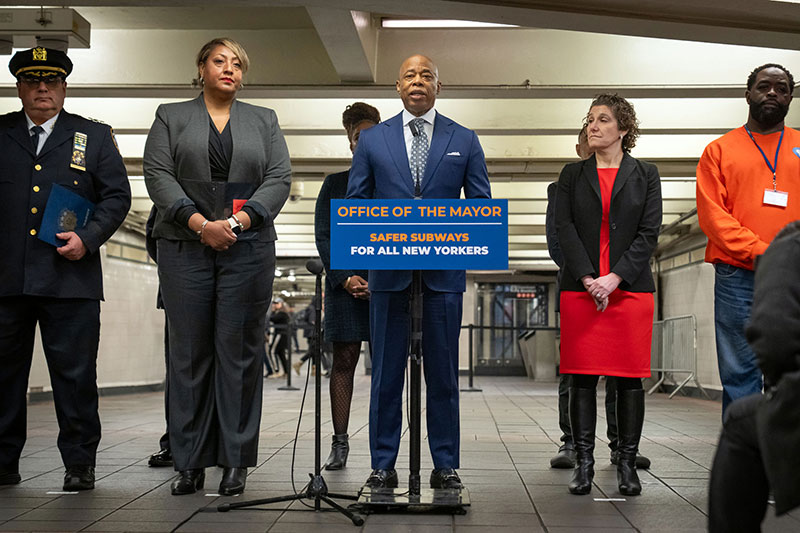NEWYORK: New York City Mayor Eric Adams kept “mental health week” moving by announcing a key milestone in the city’s Partnership Assistance for Transit Homelessness (PATH) program, which helps keep New Yorkers safe and healthy on the subway system.
Since launching in August 2024, PATH has already had over 11,000 engagements with unhoused New Yorkers and delivered services – including shelter, meals, and medical help – over 3,000 times.
Additionally, continuing to address the quality-of-life concerns of New Yorkers, members of the New York City Police Department (NYPD) issued 290 summonses and removed 911 people from the transit system for various violations of the Metropolitan Transit Authority’s (MTA) rules of conduct or state law.
The PATH initiative brings together members of the New York City Department of Homeless Services (DHS), NYC Health + Hospitals, and the NYPD Transit Bureau to connect New Yorkers living unsheltered in the subway system with shelter and care, and provides support to those with severe mental illness if unhoused and in the transit system.
PATH teams consist of DHS nurses and outreach staff working alongside NYPD transit police who conduct outreach overnight at subway stations across Manhattan from 8:00 PM to 12:00 PM the next day.
This week, the Adams administration is celebrating “Mental Health Week,” highlighting the city’s multi-agency efforts to support New Yorkers efforts to address mental health, ranging from serious mental illness to expanding resources to underserved communities – all supporting Mayor Adams’ 2025 state of the city commitment to make New York City the best place to live and raise a family.
“Keeping New Yorkers safe is the number one commitment in our administration, especially on the subways, which millions of riders rely on every day,” said Mayor Adams.
“When we came into office, we said the days of ignoring people in need – on our streets and in our subways – were over. Despite opposition, we continue to say ‘no’ to the cycle of homelessness that too often results when people with severe mental illness aren’t able to get help or are unable to recognize that they need help. That is why, as we recognize ‘Mental Health Week,’ I am so proud to share the great work our PATH team is doing to reach our most vulnerable. By using a co-response model that combines law enforcement with trained outreach and mental health professionals, this dynamic group can respond to any issue: whether it’s public safety, homelessness, or mental health. In a short period, PATH teams have already had over 11,000 engagements and delivered services over 3,000 times to New Yorkers in need. This program, combined with our Subway Safety Plan – which has already connected over 8,400 New Yorkers to shelter, with over 860 people placed in permanent, affordable housing – and our work to build unprecedented levels of supportive housing, means we are delivering on our mission to make New York City safer, more affordable, and the best place to raise a family.”
“Through our intensified subway outreach efforts, we’ve connected 8,400 New Yorkers in need to shelter, and with the expansion of proven-effective models like Safe Havens, we’ve helped nearly 3,000 New Yorkers move in to permanent homes,” said New York City Department of Social Services Commissioner Molly Wasow Park.
“With more recent initiatives like PATH we’re strengthening interagency collaboration to support harder to reach New Yorkers who are in critical need of quality care in safe and stable settings. We are grateful for our ongoing partnership with NYC Health + Hospitals, the Department of Health, and the New York City Police Department as we work together to help some of our most vulnerable New Yorkers take the first step toward stabilizing their lives.”
“The PATH program is an integral part of our mission to deter crime, improve quality-of-life conditions in our subway, and protect all New Yorkers,” said NYPD Commissioner Jessica Tisch.
“The members of the NYPD and our mental health partners go into the transit system every night to provide our most vulnerable populations with the resources they need and deserve, while providing some peace of mind to daily commuters. Crime on the subway is down double digits for the third month in a row proving that we can enhance public safety without compromising our moral duty to help those in need.”
PATH is a major advancement in the city’s embrace of “co-response” – a crisis response model gaining traction nationally, in which clinical professionals are paired with police to engage with members of the public in need of medical care and/or social services.
Participating police officers receive specialized training in crisis de-escalation and allow their clinical partners to take the lead once safety is assured. While co-response is not meant to replace traditional outreach conducted without police involvement, in certain situations, the presence of police affords clinicians a greater sense of personal safety, enabling more meaningful engagement with those in need.
Co-response also greatly enhances the ability of a clinician to initiate transport to a hospital for evaluation in circumstances where an individual exhibits symptoms of mental illness presenting a danger to themselves or others.
While in the field, the interagency PATH teams engage everyone they see who appears to be unsheltered, offering individualized support based on the person’s expressed or observed challenges.
In February 2022, Mayor Adams launched the subway safety plan to address public safety concerns and support people experiencing homelessness and severe mental illness on New York City’s subways. Since the start of the plan, over 8,400 New Yorkers have been connected to shelter, with over 860 now in permanent, affordable housing.
Mayor Adams has been on the forefront of implementing successful interventions, major investments, and direct services for people struggling with mental illness. In January 2025, following a 2025 State of the City commitment, the Adams administration took unprecedented action to curb homelessness and support people with severe mental illness by making a $650 million investment in the city’s most vulnerable populations.
Additionally, the administration unveiled an innovative model, “Bridge to Home,” where NYC Health + Hospitals will offer a supportive, home-like environment to patients with serious mental illness who are ready for discharge from the hospital but do not have a place to go. By offering patients intensive treatment and comprehensive support, Bridge to Home aims to keep patients on a path toward sustained success, reducing unnecessary emergency room visits and inpatient hospitalizations, decreasing street homelessness and reliance on shelters, and lowering interactions with the criminal justice system.
The Adams administration has made the largest investment in New York City history in creating specialized shelter beds to address street homelessness.
The city has opened 1,500 Safe Haven and stabilization beds since the start of the administration and aggressively expanded street outreach teams. Thanks to these important investments, the Adams administration has connected nearly 3,000 people experiencing unsheltered homelessness to permanent housing citywide.



